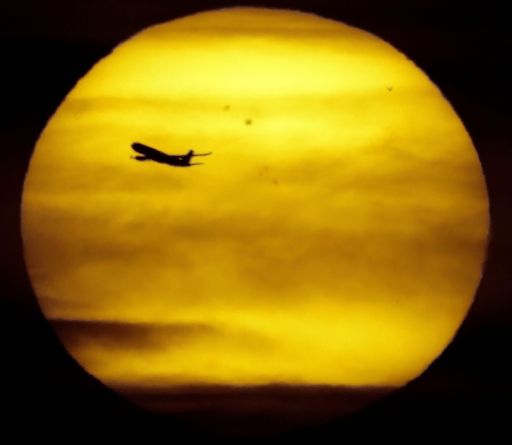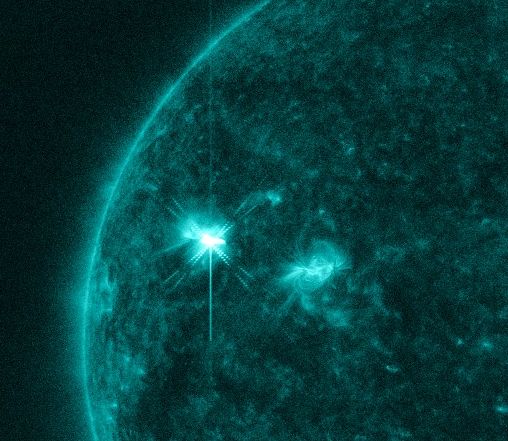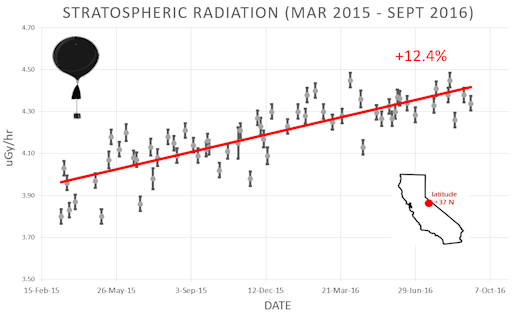Marianne's Arctic Xpress supports World Cancer Day by donating 50% of the price paid on all bookings Feb. 3-5 to cancer research. Arctic clothing and semi-pro cameras included. Groups of 2 to 8 welcome. Book Now | | | RADIATION CLOUDS AT AVIATION ALTITUDES: A new study published in the peer-reviewed journal Space Weather reports the discovery of radiation "clouds" at aviation altitudes. When airplanes fly through these clouds, dose rates of cosmic radiation normally absorbed by air travelers can double or more. [full story] NEW SUNSPOTS MATERIALIZE: Reversing the recent trend of crashing sunspot numbers, two new active regions emerged over the weekend: AR2527 and AR2528. A 48-hour movie from the Solar and Heliospheric Observatory shows their surprise emergence. The dark cores have grown so large, they are now visible in photos of the sunset, like this one captured on Sunday evening by Enrico Finotto of Treviso, Italy: 
"I caught the new sunspots just as a plane was passing by--perfect timing," says Finotto.
The sunspots announced themselves on Saturday with a flurry of minor C-class solar flares. NASA's Solar Dynamics Observatory recorded this one (C9.3) on Jan 21st at 0726 UT: 
During Solar Maximum, such a puny flare would not be mentioned as busy space weather forecasters tracked explosions 100x more potent. But now, with sunspot counts so low and flares so seldom, a C9 event is noteworthy.
If these sunspots continue to grow, solar flare activity could intensify. NOAA forecasters have boosted the of odds of moderately strong M-flares to 25%. Stay tuned for updates. Realtime Space Weather Photo Gallery SUNSET IN THE STRATOSPHERE: Nothing says "I love you" like a bear from space. To raise money for their cosmic ray research program, the students of Earth to Sky Calculus have flown a payload-full of Valentine's bears to the edge of space. This was a special flight, timed to photograph the bears at sunset in the stratosphere, wrapped in the romantic light of the fading sun 98,000 feet above Earth's surface: 
You can have one for $49.95. Each bear comes with a Valentine's card showing the bears in flight and telling the story of their trip to the stratosphere. More far-out Valentine's gifts may be found in the Earth to Sky store. All proceeds support cosmic ray balloon flights and STEM education. Realtime Aurora Photo Gallery
Realtime Airglow Photo Gallery
Realtime Sprite Photo Gallery Every night, a network of NASA all-sky cameras scans the skies above the United States for meteoritic fireballs. Automated software maintained by NASA's Meteoroid Environment Office calculates their orbits, velocity, penetration depth in Earth's atmosphere and many other characteristics. Daily results are presented here on Spaceweather.com. On Jan. 22, 2017, the network reported 14 fireballs.
(14 sporadics)  In this diagram of the inner solar system, all of the fireball orbits intersect at a single point--Earth. The orbits are color-coded by velocity, from slow (red) to fast (blue). [Larger image] [movies] Potentially Hazardous Asteroids ( PHAs) are space rocks larger than approximately 100m that can come closer to Earth than 0.05 AU. None of the known PHAs is on a collision course with our planet, although astronomers are finding new ones all the time. On January 22, 2017 there were potentially hazardous asteroids. Notes: LD means "Lunar Distance." 1 LD = 384,401 km, the distance between Earth and the Moon. 1 LD also equals 0.00256 AU. MAG is the visual magnitude of the asteroid on the date of closest approach. | | Cosmic Rays in the Atmosphere |
Readers, thank you for your patience while we continue to develop this new section of Spaceweather.com. We've been working to streamline our data reduction, allowing us to post results from balloon flights much more rapidly, and we have developed a new data product, shown here: 
This plot displays radiation measurements not only in the stratosphere, but also at aviation altitudes. Dose rates are expessed as multiples of sea level. For instance, we see that boarding a plane that flies at 25,000 feet exposes passengers to dose rates ~10x higher than sea level. At 40,000 feet, the multiplier is closer to 50x. These measurements are made by our usual cosmic ray payload as it passes through aviation altitudes en route to the stratosphere over California. What is this all about? Approximately once a week, Spaceweather.com and the students of Earth to Sky Calculus fly space weather balloons to the stratosphere over California. These balloons are equipped with radiation sensors that detect cosmic rays, a surprisingly "down to Earth" form of space weather. Cosmic rays can seed clouds, trigger lightning, and penetrate commercial airplanes. Furthermore, there are studies ( #1, #2, #3, #4) linking cosmic rays with cardiac arrhythmias and sudden cardiac death in the general population. Our latest measurements show that cosmic rays are intensifying, with an increase of more than 12% since 2015: 
Why are cosmic rays intensifying? The main reason is the sun. Solar storm clouds such as coronal mass ejections (CMEs) sweep aside cosmic rays when they pass by Earth. During Solar Maximum, CMEs are abundant and cosmic rays are held at bay. Now, however, the solar cycle is swinging toward Solar Minimum, allowing cosmic rays to return. Another reason could be the weakening of Earth's magnetic field, which helps protect us from deep-space radiation. The radiation sensors onboard our helium balloons detect X-rays and gamma-rays in the energy range 10 keV to 20 MeV. These energies span the range of medical X-ray machines and airport security scanners. The data points in the graph above correspond to the peak of the Reneger-Pfotzer maximum, which lies about 67,000 feet above central California. When cosmic rays crash into Earth's atmosphere, they produce a spray of secondary particles that is most intense at the entrance to the stratosphere. Physicists Eric Reneger and Georg Pfotzer discovered the maximum using balloons in the 1930s and it is what we are measuring today. | | The official U.S. government space weather bureau | | | The first place to look for information about sundogs, pillars, rainbows and related phenomena. | | | Researchers call it a "Hubble for the sun." SDO is the most advanced solar observatory ever. | | | 3D views of the sun from NASA's Solar and Terrestrial Relations Observatory | | | Realtime and archival images of the Sun from SOHO. | | | from the NOAA Space Environment Center | | | a proud supporter of science education and Spaceweather.com | | | the underlying science of space weather |  | Beautyz for top beauty products reviews and their buying guides | | | These links help Spaceweather.com stay online. Thank you to our supporters! | | 
